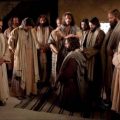Question
Dear Gramps,
Has the Mormon Church said anything regarding the Shroud of Turin?
Louise
Answer
Dear Louise,
The Shroud of Turin, an ancient linen cloth bearing the faint image of a man who appears to have suffered crucifixion, has captivated hearts and minds for centuries. Believed by some to be the burial shroud of Jesus Christ, its authenticity and significance have sparked extensive debate across various Christian denominations. Members of The Church of Jesus Christ of Latter-day Saints (LDS), while not possessing an official stance on the Shroud, engage with its implications through the lens of faith, resurrection, and the teachings of Jesus Christ.
The Shroud of Turin first became publicly known in the 14th century, and since then, it has been the subject of intense scrutiny and reverence. Historical records indicate that the Shroud bears the image of a man who appears to have been crucified, leading many to wonder whether it could indeed be the burial cloth of Jesus. While scientific investigations, including carbon dating, have produced mixed results concerning its age, the Shroud has retained its status as a significant artifact within Christianity. For members of the LDS Church, the Shroud serves as a reminder of Christ’s sacrifice and resurrection, central tenets of their faith.
Hugh Nibley, a prominent LDS scholar, articulated the importance of ancient artifacts in understanding the gospel, discussing how they can symbolize deeper spiritual truths. Nibley emphasized that while historical artifacts, such as the Shroud, may hold value, the essence of faith lies in the teachings of Christ and the doctrine of resurrection. He stated, “The purpose of these ancient symbols is to help us understand the divine interaction in human affairs” (Nibley, 1979). This perspective allows Latter-day Saints to appreciate the Shroud not merely as an object of scientific inquiry but as a potential conduit for spiritual reflection.
For many Latter-day Saints, the Shroud can be viewed through the lens of faith rather than solely scientific validation. The focus remains on the resurrection of Jesus Christ, an event that holds profound significance within the Church. As articulated in 1 Corinthians 15, the resurrection is a cornerstone of Christian belief, emphasizing that through Christ’s victory over death, all humanity can also overcome mortality.
Despite the lack of an official position on the Shroud, its image resonates deeply with the themes of resurrection and atonement in LDS theology. Members of the Church often reflect on the Shroud as a representation of Christ’s suffering and ultimate triumph, reinforcing their belief in His divine mission. The Shroud serves as a reminder of the hope and comfort that the resurrection provides, encouraging faithful adherence to the principles of the gospel.
In this context, the Shroud also symbolizes the broader narrative of Christ’s life, death, and resurrection—the core of LDS teaching. By focusing on the spiritual truths conveyed through such artifacts, Latter-day Saints are reminded of their covenantal relationship with God and the eternal nature of life after death.
The relationship between science and faith is a pivotal theme within the teachings of The Church of Jesus Christ of Latter-day Saints. While members may appreciate scientific inquiries into the Shroud, they ultimately regard the resurrection and the teachings of Jesus Christ as foundational to their beliefs—independent of the Shroud’s authenticity. This perspective reflects the Church’s emphasis on faith alongside reason, where both realms can coexist in the pursuit of truth.
Scientific investigations into the Shroud have produced a plethora of findings, including an analysis of its fibers and the image itself. Some scientists argue that the unique properties of the Shroud indicate its authenticity as a burial cloth, while others maintain that it is a medieval forgery. Such debates illustrate the intersection of science and faith, highlighting how both can contribute to a deeper understanding of spiritual matters within the LDS framework.
Nibley’s reflections on the Shroud and similar artifacts reaffirm the notion that faith is not contingent upon physical evidence. He posits that the essence of faith lies in the personal relationship with the divine and the teachings of Christ, which transcend the validity of any artifact. This perspective encourages members of the Church to engage with the Shroud as a tool for spiritual contemplation rather than a definitive proof of Christ’s existence or resurrection.
The Shroud of Turin has sparked interest in cultural and religious circles, leading to various interpretations and beliefs. In the context of the LDS community, the Shroud can be viewed as a piece of sacred art that invites reverence and contemplation. While recognizing its significance, Latter-day Saints often emphasize a broader narrative that encompasses the life and teachings of Jesus Christ.
Spiritual artifacts within LDS theology serve as reminders of the divine and can help foster faith in the teachings of the Church. The Shroud, though historical in nature, aligns with the spiritual beliefs of Latter-day Saints, reinforcing the belief in resurrection and the eternal nature of life after death. This relationship between artifacts and faith exemplifies the importance of symbols in nurturing belief and spiritual growth.
As noted by John Tvedtnes, another respected LDS scholar, the significance of the Shroud extends beyond its physical properties. He states, “The value of such artifacts lies not in their authenticity, but in their ability to inspire faith and reflection among believers” (Tvedtnes, 1999). This understanding encourages members of the Church to engage with the Shroud in a manner that fosters spiritual growth and deeper connections to their faith.
While the Shroud of Turin remains a topic of debate among historians and scientists, its spiritual significance and connection to the teachings of Jesus Christ are recognized within The Church of Jesus Christ of Latter-day Saints. Members of the Church approach the Shroud with a faith-centered perspective, emphasizing the resurrection and atonement of Christ as the core of their beliefs. Through the lens of faith, the Shroud serves as a powerful reminder of the hope and promise of eternal life, encouraging contemplation of the divine and fostering a deeper understanding of the gospel.
Gramps







